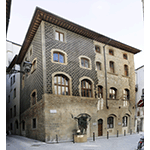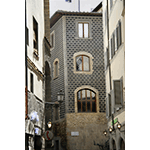Accademia dei Georgofili [Georgofili Academy]
Established in Florence on June 4, 1753 at the initiative of the Lateran Canon Ubaldo Montelatici, the Accademia dei Georgofili was the first public association in Europe dedicated to agrarian studies. It originated from the need to improve agricultural production through rational utilisation of the soil. In 1783 it merged with the Botany Society and received in concession the "Giardino dei Semplici" (medicinal herb garden). With Grand Duke Peter Leopold of Lorraine, who granted it his protection, the Accademia acquired notable prestige. It raised numerous issues (renewal of agricultural equipment, agricultural education, marketing grain, raising cattle, tenant farming, draining swamplands, etc.) presented, starting from 1791, in the "Proceedings of the Royal Economics Society of Florence, that is, the Georgofili", whose publishing activity still continues today. Another journal utilised by the members was the "Giornale Agrario Toscano", founded in 1827 by three important members of the Accademia (Raffaello Lambruschini, Lapo de' Ricci, and Cosimo Ridolfi), and published by Giovan Pietro Vieusseux; the latter journal merged with the "Proceedings" in 1830.
The Academy also played the role of juridical-agrarian consultant. In the early years of the 18th century, at the request of Napoleon Bonaparte, it examined the new rural Law Code; under Ferdinand III, it participated in compiling the land office registry of the Grand Duchy. In 1829 it promoted the Cassa di Risparmio di Florence, and in 1831 Cosimo Ridolfi, President of the Georgofili, founded the first agricultural school in Italy at his farm of Meleto.
The Academy has always favoured the establishing of institutions for agrarian education and experimentation, and has organised national and international conferences. A very active institution, it has a vast Library today (nearly 70,000 volumes) and an important Archive. On May 27, 1993, a criminal attack struck a severe blow at the Academy, seriously damaging part of its artistic and library heritage. In 1996, after patient restoration work, it was rebuilt in its ancient form and the Library was almost entirely reinstated.
****************************
Texts by Graziano Magrini
English translation by Catherine Frost
Last update 21/feb/2008





